The Bush Dog
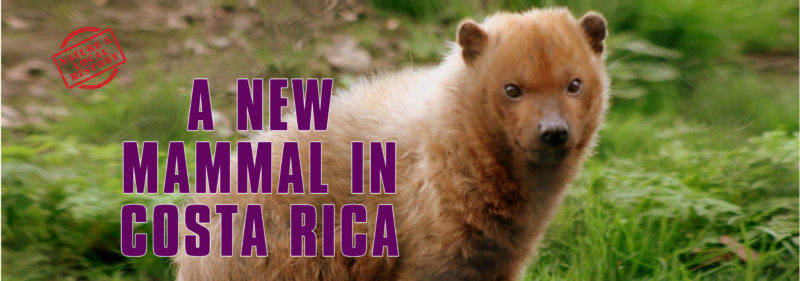
By Jack Ewing
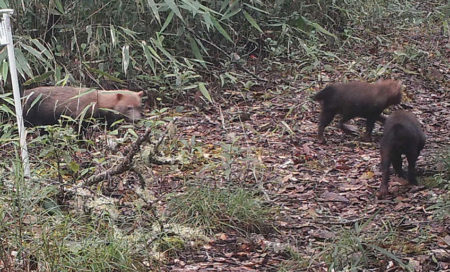 Rarely is a new mammal discovered anywhere on the planet. Insects, yes. In fact so many new insect species are being discovered every day that it is not even newsworthy. Species of reptiles and amphibians new to Costa Rica are found at least once a year, birds occasionally, but 2016 was the first time a new mammal species has been confirmed in Costa Rica during the 48 years that I have lived here. I am referring to the Bush Dog (Speothos venaticus), a member of the canidae family sometimes called the Savannah Dog or the Vinegar Dog. A video of a pair of them was captured on a trail camera by biologist Jan Shipper in the Talamanca region at 1493 meters (4900 feet) above sea level. Prior to that time there had been several unconfirmed sightings in the Osa Peninsula, but no photos. It was believed that Shipper’s video was taken at the highest elevation where bush dog presence had been detected anywhere throughout its range. A couple of years later Dr. Mike Mooring, of the Talamanca Large Mammal Survey, captured photos of several groups of these canids at an elevation of 2086 mt (6844 feet). Prior to Jan Shipper’s video the species was not known to exist north of Panama.
Rarely is a new mammal discovered anywhere on the planet. Insects, yes. In fact so many new insect species are being discovered every day that it is not even newsworthy. Species of reptiles and amphibians new to Costa Rica are found at least once a year, birds occasionally, but 2016 was the first time a new mammal species has been confirmed in Costa Rica during the 48 years that I have lived here. I am referring to the Bush Dog (Speothos venaticus), a member of the canidae family sometimes called the Savannah Dog or the Vinegar Dog. A video of a pair of them was captured on a trail camera by biologist Jan Shipper in the Talamanca region at 1493 meters (4900 feet) above sea level. Prior to that time there had been several unconfirmed sightings in the Osa Peninsula, but no photos. It was believed that Shipper’s video was taken at the highest elevation where bush dog presence had been detected anywhere throughout its range. A couple of years later Dr. Mike Mooring, of the Talamanca Large Mammal Survey, captured photos of several groups of these canids at an elevation of 2086 mt (6844 feet). Prior to Jan Shipper’s video the species was not known to exist north of Panama.
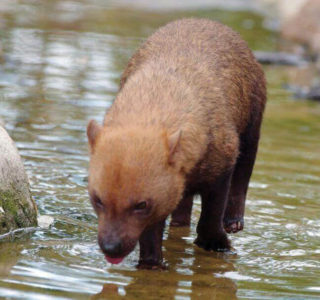 It is possible that bush dogs had been present in Costa Rica for a long time but were never detected. However, Shipper had been working with trail cameras in the Talamanca region for 12 years prior to that first video without detecting a single one. It seems likely that they are migrating into remote parts of Costa Rica from Panama and adapting to higher elevations where there is less human encroachment. Though they are known to exist in all of the countries between Panama and northern Argentina, and in many different habitats including mangrove, swamp forests, savannas, secondary forest, and primary forest, sightings are rare, and little is known about these fascinating carnivores.
It is possible that bush dogs had been present in Costa Rica for a long time but were never detected. However, Shipper had been working with trail cameras in the Talamanca region for 12 years prior to that first video without detecting a single one. It seems likely that they are migrating into remote parts of Costa Rica from Panama and adapting to higher elevations where there is less human encroachment. Though they are known to exist in all of the countries between Panama and northern Argentina, and in many different habitats including mangrove, swamp forests, savannas, secondary forest, and primary forest, sightings are rare, and little is known about these fascinating carnivores.
Fossils of Speothos venaticus were discovered and the species named many years ago by Peter Wilhelm Lund. He found them in caves located in Brazil. The species was thought to be extinct. Today we know that not only are they not extinct but that they are quite widespread. Nevertheless sightings are few, and research is almost non-existent, mainly due to the difficulty of locating and studying the species. Much of the available knowledge about their habits is anecdotal or comes from the observation of zoo animals whose behavior can be markedly different from wild animals.
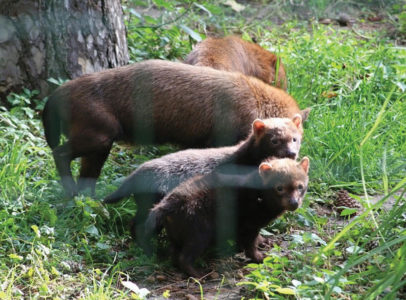 Bush dogs exude a strong odor similar to vinegar which gives rise to the nickname “vinegar dog”. The odor is apparently very distinctive as the same nickname occurs in three languages throughout the species’ range. They have been described as about the size of a terrier. Wild animals weigh around 8 kilos (17½ pounds) and stand about 30 cm (12 inches) at the shoulder. The body is long and the tail short. The thick coat is reddish brown to black, being lighter on the head and back and black on the tail. Bush dogs have webbed feet and are excellent swimmers.
Bush dogs exude a strong odor similar to vinegar which gives rise to the nickname “vinegar dog”. The odor is apparently very distinctive as the same nickname occurs in three languages throughout the species’ range. They have been described as about the size of a terrier. Wild animals weigh around 8 kilos (17½ pounds) and stand about 30 cm (12 inches) at the shoulder. The body is long and the tail short. The thick coat is reddish brown to black, being lighter on the head and back and black on the tail. Bush dogs have webbed feet and are excellent swimmers.
Most hunting is done in packs allowing them to subdue species larger than themselves, including pacas, agoutis, armadillos, and peccaries. There is even one report of a pack of bush dogs harassing a tapir. Six to ten individuals consisting of an alpha pair and a number of apparent family members comprise the pack. Only the alpha pair mate and reproduce, and the entire pack cares for the offspring. According to studies of zoo animals the alpha female uses hormones to prevent other females from coming into estrus. In captivity litters of as many as 10 pups have been recorded, but in the wild the number is usually four or five. Like domestic dogs the newborn are blind and helpless. Hollow logs and burrows made by other animals such as armadillos and pacas serve as dens.
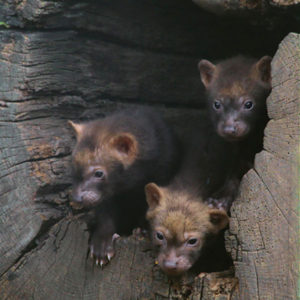 Hopefully the bush dogs will find a niche in Costa Rica, remain here permanently, and expand their range. They have demonstrated a great deal of adaptability by living in many different habitats and climates at different elevations. It is even conceivable that they could migrate as far as the Path of the Tapir Biological Corridor in the coastal region south of Quepos. There is a continuous forest corridor from the Amistad International Park near the Panamanian border all the way to the Los Santos Forest Reserve northeast of Quepos. It would mean migrating into even higher elevations than previously documented, but adaptability is one of Speothos venaticus’ strong points.
Hopefully the bush dogs will find a niche in Costa Rica, remain here permanently, and expand their range. They have demonstrated a great deal of adaptability by living in many different habitats and climates at different elevations. It is even conceivable that they could migrate as far as the Path of the Tapir Biological Corridor in the coastal region south of Quepos. There is a continuous forest corridor from the Amistad International Park near the Panamanian border all the way to the Los Santos Forest Reserve northeast of Quepos. It would mean migrating into even higher elevations than previously documented, but adaptability is one of Speothos venaticus’ strong points.
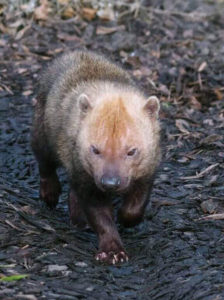 As with other mammals human encroachment on their habitat is a major threat. Another is reduction of prey animal populations due to illegal hunting. Hunting of any species is illegal throughout Costa Rica, but enforcement is lax. Unless this changes, lack of prey could be a serious threat to bush dogs. A third threat comes from another canid species, domestic dogs. Bush dogs have been known to contract diseases such as distemper, parvovirus, and rabies. Fortunately they don’t seem to have an affinity for human settlements, and this threat may not become a major problem.
As with other mammals human encroachment on their habitat is a major threat. Another is reduction of prey animal populations due to illegal hunting. Hunting of any species is illegal throughout Costa Rica, but enforcement is lax. Unless this changes, lack of prey could be a serious threat to bush dogs. A third threat comes from another canid species, domestic dogs. Bush dogs have been known to contract diseases such as distemper, parvovirus, and rabies. Fortunately they don’t seem to have an affinity for human settlements, and this threat may not become a major problem.
I want to thank Dr. Mike Mooring of the Talamanca Large Mammal Survey, which is sponsored by the Quetzal Research Center, for all of the trail camera photos and a wealth of information. Many of the other photos were taken from the websites of various zoos that have bush dogs.


I observed two Bush Dogs at Finca Cantaros in Linda Vista de San Vito about five years ago, November, probably 2013. It was the wet season. They were identical in size and were hunting very near the trail as I was approaching with my dog. They moved close together very fast across my path to escape, and I got a reasonable look at them as they headed northeast in the direction of Panama. (Finca Cantaros is just seven km from the border). Though I had my camera there was absolutely no time to get a shot. They were blazingly fast and low to the ground.
Jack, my worker took pictures of a family of bush dogs on our property only about one kilometer away from your refuge. When his pit bull (about 25 kgs.)ran up to them, the largest one was able to grab her by the neck and toss her. This happened in December. No recent sightings.
Jack:
We have these in our neighborhood. (Dominical/ Hatillo area) I know of three sightings in the past six months.
Warm regards
Joe